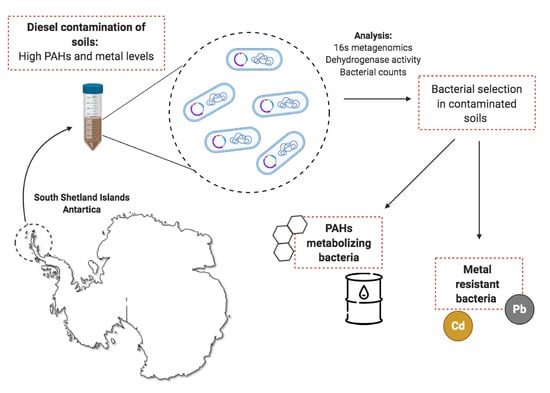Effect of Co-contamination by PAHs and Heavy Metals on Bacterial Communities of Diesel Contaminated Soils of South Shetland Islands, Antarctica
Abstract
1. Introduction
2. Materials and Methods
2.1. Reagents
2.2. Soil Sampling
2.3. Analysis of Chemical Parameters
2.4. Analysis of Biological Parameters
2.5. 16S rRNA Gene Analysis
2.6. Isolation of Phenanthrene Degrading Bacteria
2.7. Data Analysis
3. Results
3.1. Antarctic Diesel-Exposed Soils Contain High Concentrations of PAHs and Heavy Metals
3.2. Bacterial Communities of Diesel-Exposed Soils
3.3. Biological Activity of Diesel-Exposed Soils Is Less Affected by Cadmium than Control Soils
3.4. Diesel-Exposed Soils Present an Increased Number of Cadmium-tolerant and PAH Metabolizing Bacteria
4. Discussion
4.1. PAHs and Metal Contamination on Diesel-Exposed Antarctic Soils
4.2. Bacterial Communities Inhabiting Diesel-Exposed Soils
4.3. Effect of PAHs and Cadmium on Dehydrogenase Activity, CFUs, and PAHs Degrading Bacteria
Supplementary Materials
Author Contributions
Funding
Acknowledgments
Conflicts of Interest
References
- De Ferro, A.M.; Mota, A.M.; Canário, J. Sources and transport of As, Cu, Cd and Pb in the environmental compartments of Deception Island, Antarctica. Mar. Pollut. Bull. 2013, 77, 341–348. [Google Scholar] [CrossRef]
- Szopińska, M.; Namieśnik, J.; Polkowska, Ż. How important is research on pollution levels in Antarctica? Historical approach, difficulties and current trends. Rev. Environ. Contam. Toxicol. 2017, 239, 79–156. [Google Scholar] [CrossRef]
- Tin, T.; Fleming, Z.; Hughes, K.A.; Ainley, D.; Convey, P.; Moreno, C.; Pfeiffer, S.; Scott, J.; Snape, I. Impacts of local human activities on the Antarctic environment. Antarct. Sci. 2009, 21, 3–33. [Google Scholar] [CrossRef]
- Bargagli, R. Environmental contamination in Antarctic ecosystems. Sci. Total Environ. 2008, 400, 212–226. [Google Scholar] [CrossRef]
- Aislabie, J.; Balks, M.; Fogth, J.; Waterhouse, E. Hydrocarbon spills on Antarctic soils: Effects and management. Environ. Sci. Technol. 2004, 38, 1265–1274. [Google Scholar] [CrossRef] [PubMed]
- Cerniglia, C.E. Biodegradation of polycyclic aromatic hydrocarbons. Biodegradation 1992, 3, 351–368. [Google Scholar] [CrossRef]
- Dabestani, R.; Lvanov, I.N. A compilation of physical, spectroscopic and photophysical properties of polycyclic aromatic hydrocarbons. Photochem. Photobiol. 1999, 70, 10–34. [Google Scholar] [CrossRef]
- Woolfenden EN, M.; Hince, G.; Powell, S.M.; Stark, S.C.; Snape, I.; Stark, J.S.; George, S.C. The rate of removal and the compositional changes of diesel in Antarctic marine sediment. Sci. Total Environ. 2011, 410–411, 205–216. [Google Scholar] [CrossRef] [PubMed]
- Perez, J.M.; Calderón, I.L.; Arenas, F.A.; Fuentes, D.E.; Pradenas, G.A.; Fuentes, E.L.; Sandoval, J.M.; Castro, M.E.; Elías, A.O.; Vásquez, C.C. Bacterial toxicity of potassium tellurite: Unveiling an ancient enigma. PLoS ONE 2007, 2, e0000211. [Google Scholar] [CrossRef] [PubMed]
- Pérez, J.M.; Arenas, F.A.; Pradenas, G.A.; Sandoval, J.M.; Vásquez, C.C. Escherichia coli YqhD exhibits aldehyde reductase activity and protects from the harmful effect of lipid peroxidation-derived aldehydes. J. Biol. Chem. 2008, 283, 7346–7353. [Google Scholar] [CrossRef]
- Barra, C.; Toledo, C.; Richter, P.; Pre, M. Alkanes and polycyclic aromatic hydrocarbons in marine surficial sediment near Antarctic stations at Fildes Peninsula, King George Island. Antarct. Sci. 2011, 23, 578–588. [Google Scholar] [CrossRef]
- Snape, I.; Ferguson, S.H.; Harvey, P.M.A.; Riddle, M.J. Investigation of evaporation and biodegradation of fuel spills in Antarctica: II—Extent of natural attenuation at Casey Station. Chemosphere 2006, 63, 89–98. [Google Scholar] [CrossRef]
- Poland, J.S.; Riddle, M.J.; Zeeb, B.A. Contaminants in the Arctic and the Antarctic: A comparison of sources, impacts, and remediation options. Polar Rec. 2003, 39, 369. [Google Scholar] [CrossRef]
- Aislabie, J.; Balks, M.; Astori, N.; Stevenson, G.; Symons, R. Polycyclic aromatic hydrocarbons in fuel-contaminated soils, Antarctica. Chemosphere 1999, 39, 2201–2207. [Google Scholar] [CrossRef]
- Padeiro, A.; Amaro, E.; Dos Santos, M.M.C.; Araújo, M.F.; Gomes, S.S.; Leppe, M.; Verkulich, S.; Hughes, K.A.; Peter, H.-U.; Canário, J. Trace element contamination and availability in the Fildes Peninsula, King George Island, Antarctica. Environ. Sci. Process. Impacts 2016, 18, 648–657. [Google Scholar] [CrossRef]
- Rayner, J.L.; Snape, I.; Walworth, J.L.; Harvey, P.M.; Ferguson, S.H. Petroleum-hydrocarbon contamination and remediation by microbioventing at sub-Antarctic Macquarie Island. Cold Reg. Sci. Technol. 2007, 48, 139–153. [Google Scholar] [CrossRef]
- Schafer, A.N.; Snape, I.; Siciliano, S.D. Soil biogeochemical toxicity end points for sub-Antarctic islands contaminated with petroleum hydrocarbons. Environ. Toxicol. Chem. 2007, 26, 890–897. [Google Scholar] [CrossRef]
- Trevizani, T.H.; Petti, M.A.V.; Ribeiro, A.P.; Corbisier, T.N.; Figueira, R.C.L. Heavy metal concentrations in the benthic trophic web of Martel Inlet, Admiralty Bay (King George Island, Antarctica). Mar. Pollut. Bull. 2018, 130, 198–205. [Google Scholar] [CrossRef]
- Carrasco, A.P.M. Elements distribution of some soils of continental Chile and the Antarctic Peninsula. Projection to atmospheric pollution. Water Air Soil Pollut. 1991, 57, 713–722. [Google Scholar] [CrossRef]
- Lu, Z.; Cai, M.; Wang, J.; Yang, H.; He, J. Baseline values for metals in soils on Fildes Peninsula, King George Island, Antarctica: The extent of anthropogenic pollution. Environ. Monit. Assess. 2012, 184, 7013–7021. [Google Scholar] [CrossRef]
- de Lima Neto, E.; Guerra, M.B.B.; Thomazini, A.; Daher, M.; de Andrade, A.M.; Schaefer, C.E.G.R. Soil contamination by toxic metals near an antarctic refuge in robert island, maritime Antarctica: A monitoring strategy. Water Air Soil Pollut. 2017, 228. [Google Scholar] [CrossRef]
- Amaro, E.; Padeiro, A.; De Ferroa, A.M.; Mota, A.M.; Leppe, M.; Verkulich, S.; Hughes, K.A.; Peter, H.-U.; Canário, J. Assessing trace element contamination in Fildes Peninsula (King George Island) and Ardley Island, Antarctic. Mar. Pollut. Bull. 2015, 97, 523–527. [Google Scholar] [CrossRef]
- Zhang, Z.; Rengel, Z.; Meney, K.; Pantelic, L.; Tomanovic, R. Polynuclear aromatic hydrocarbons (PAHs) mediate cadmium toxicity to an emergent wetland species. J. Hazard. Mater. 2011, 189, 119–126. [Google Scholar] [CrossRef]
- Sandrin, T.R.; Maier, R.M. Impact of metals on the biodegradation of organic pollutants. Environ. Health Perspect. 2003, 111, 1093–1101. [Google Scholar] [CrossRef]
- Thavamani, P.; Malik, S.; Beer, M.; Megharaj, M.; Naidu, R. Microbial activity and diversity in long-term mixed contaminated soils with respect to polyaromatic hydrocarbons and heavy metals. J. Environ. Manag. 2012, 99, 10–17. [Google Scholar] [CrossRef]
- Thavamani, P.; Megharaj, M.; Naidu, R. Multivariate analysis of mixed contaminants (PAHs and heavy metals) at manufactured gas plant site soils. Environ. Monit. Assess. 2012, 184, 3875–3885. [Google Scholar] [CrossRef]
- Muthusamy, S.; Peng, C.; Ng, J.C. Effects of multi-component mixtures of polyaromatic hydrocarbons and heavy metal/loid(s) on Nrf2-antioxidant response element (ARE) pathway in ARE reporter-HepG2 cells. Toxicol. Res. 2016, 5, 1160–1171. [Google Scholar] [CrossRef]
- Thavamani, P.; Megharaj, M.; Naidu, R. Metal-tolerant PAH-degrading bacteria: Development of suitable test medium and effect of cadmium and its availability on PAH biodegradation. Environ. Sci. Pollut. Res. 2015, 22, 8957–8968. [Google Scholar] [CrossRef]
- Trevizani, T.H.; Figueira, R.C.L.; Ribeiro, A.P.; Theophilo, C.Y.S.; Majer, A.P.; Petti, M.A.V.; Corbisier, T.N.; Montone, R.C. Bioaccumulation of heavy metals in marine organisms and sediments from Admiralty. Mar. Pollut. Bull. 2016, 106, 366–371. [Google Scholar] [CrossRef]
- Thompson, B.A.W.; Goldsworthy, P.M.; Riddle, M.J.; Snape, I.; Stark, J.S. Contamination effects by a “conventional” and a “biodegradable” lubricant oil on infaunal recruitment to Antarctic sediments: A field experiment. J. Exp. Mar. Biol. Ecol. 2007, 340, 213–226. [Google Scholar] [CrossRef]
- Stark, J.S.; Snape, I.; Riddle, M.J. The effects of petroleum hydrocarbon and heavy metal contamination of marine sediments on recruitment of Antarctic soft-sediment assemblages: A field experimental investigation. J. Exp. Mar. Biol. Ecol. 2003, 283, 21–50. [Google Scholar] [CrossRef]
- Weber, K.; Goerke, H. Persistent organic pollutants (POPs) in Antarctic fish: Levels, patterns, changes. Chemosphere 2003, 53, 667–678. [Google Scholar] [CrossRef]
- Corsolini, S.; Ademollo, N.; Martellini, T.; Randazzo, D.; Vacchi, M.; Cincinelli, A. Legacy persistent organic pollutants including PBDEs in the trophic web of the Ross Sea (Antarctica). Chemosphere 2017, 185, 699–708. [Google Scholar] [CrossRef] [PubMed]
- Lohan, M.C.; Statham, P.J.; Peck, L. Trace metals in the Antarctic soft-shelled clam Laternula elliptica: Implications for metal pollution from Antarctic research stations. Polar Biol. 2001, 24, 808–817. [Google Scholar] [CrossRef]
- Lana, N.B.; Berton, P.; Covaci, A.; Ciocco, N.F.; Barrera-Oro, E.; Atencio, A.; Altamirano, J.C. Fingerprint of persistent organic pollutants in tissues of Antarctic notothenioid fish. Sci. Total Environ. 2014, 499, 89–98. [Google Scholar] [CrossRef]
- Jurelevicius, D.; Raposo, S.; Peixoto, R.; Soares, A.; Seldin, L. Distribution of alkane-degrading bacterial communities in soils from King George Island, Maritime Antarctic. Eur. J. Soil Biol. 2012, 51, 37–44. [Google Scholar] [CrossRef]
- Aislabie, J.; Fraser, R.; Duncan, S.; Farrell, R.L. Effects of oil spills on microbial heterotrophs in Antarctic soils. Polar Biol. 2001, 24, 308–313. [Google Scholar] [CrossRef]
- Saul, D.J.; Aislabie, J.M.; Brown, C.E.; Harris, L.; Foght, J.M. Hydrocarbon contamination changes the bacterial diversity of soil from around Scott Base, Antarctica. FEMS Microbiol. Ecol. 2005, 53, 141–155. [Google Scholar] [CrossRef]
- Powell, S.M.; Bowman, J.P.; Ferguson, S.H.; Snape, I. The importance of soil characteristics to the structure of alkane-degrading bacterial communities on sub-Antarctic Macquarie Island. Soil Biol. Biochem. 2010, 42, 2012–2021. [Google Scholar] [CrossRef]
- Balks, M.R.; Aislabie, J.; Foght, J. Preliminary assessment of the constraints to biodegradation of fuel spills in Antarctic soils/Evaluation préliminaire des limites de la biodégradation d’hydrocarbures issus de déversements accidentels dans les sols de l’Antarctique. In Proceedings of the 16th World Congress of Soil Science, Montpellier, France, 20–26 August 1998; p. II-694. Available online: http://natres.psu.ac.th/Link/SoilCongress/bdd/symp38/1132-t.pdf (accessed on 25 September 2020).
- Aislabie, J.; Mcleod, M.; Fraser, R. Potential for biodegradation of hydrocarbons in soil from the Ross dependency, Antarctica. Appl. Microbiol. Biotechnol. 1998, 49, 210–214. [Google Scholar] [CrossRef]
- Powell, S.M.; Bowman, J.P.; Snape, I.; Stark, J.S. Microbial community variation in pristine and polluted nearshore Antarctic sediments. FEMS Microbiol. Ecol. 2003, 45, 135–145. [Google Scholar] [CrossRef]
- Powell, S.M.; Bowman, J.P.; Snape, I. Degradation of nonane by bacteria from Antarctic marine sediment. Polar Biol. 2004, 27, 573–578. [Google Scholar] [CrossRef]
- Gran-Scheuch, A.; Fuentes, E.; Bravo, D.M.; Jiménez, J.C.; Pérez-Donoso, J.M. Isolation and Characterization of Phenanthrene Degrading Bacteria from Diesel Fuel-Contaminated Antarctic Soils. Front. Microbiol. 2017, 8, 1634. [Google Scholar] [CrossRef]
- Reasoner, D.J.; Geldreich, E.E. A new medium for the enumeration and subculture of bacteria from potable water. Appl. Environ. Microbiol. 1985, 49, 1–7. [Google Scholar] [CrossRef] [PubMed]
- Lierop, W.V.; MacKenzie, A.F. Soil pH measurement and its application to organic soils. Can. J. Soil Sci. 1977, 57, 55–64. [Google Scholar] [CrossRef]
- Alarcón, F.; Báez, M.E.; Bravo, M.; Richter, P.; Escandar, G.M.; Olivieri, A.C.; Fuentes, E. Feasibility of the determination of polycyclic aromatic hydrocarbons in edible oils via unfolded partial least-squares/residual bilinearization and parallel factor analysis of fluorescence excitation emission matrices. Talanta 2013, 103, 361–370. [Google Scholar] [CrossRef] [PubMed]
- Lee, C.K.; Ko, E.J.; Kim, K.W.; Kim, Y.J.; Lee, C.K.; Ko, E.J.; Kim, K.W.; Kim, Y.J. Partial least square regression method for the detection of polycyclic aromatic hydrocarbons in the soil environment using laser-induced fluorescence spectroscopy. Water Air Soil Pollut. 2004, 158, 261–275. [Google Scholar] [CrossRef]
- Alarcón, F.; Báez, M.E.; Bravo, M.; Richter, P.; Fuentes, E. Screening of edible oils for polycyclic aromatic hydrocarbons using microwave-assisted liquid-liquid and solid phase extraction coupled to one- to three-way fluorescence spectroscopy analysis. Talanta 2012, 100, 439–446. [Google Scholar] [CrossRef]
- Fuentes, E.; Báez, M.E.; Reyes, D. Microwave-assisted extraction through an aqueous medium and simultaneous cleanup by partition on hexane for determining pesticides in agricultural soils by gas chromatography: A critical study. Anal. Chim. Acta 2006, 578, 122–130. [Google Scholar] [CrossRef]
- Casida, L.E. Microbial metabolic activity in soil as measured by dehydrogenase determinations. Appl. Environ. Microbiol. 1977, 34, 630–636. [Google Scholar] [CrossRef]
- Gallardo, C.; Monrás, J.; Plaza, D.; Collao, B.; Saona, L.; Durán-Toro, V.; Venegas, F.; Soto, C.; Ulloa, G.; Vásquez, C.; et al. Low-temperature biosynthesis of fluorescent semiconductor nanoparticles (CdS) by oxidative stress resistant Antarctic bacteria. J. Biotechnol. 2014, 187. [Google Scholar] [CrossRef] [PubMed]
- Caporaso, J.G.; Kuczynski, J.; Stombaugh, J.; Bittinger, K.; Bushman, F.D.; Costello, E.K.; Fierer, N.; Peña, A.G.; Goodrich, J.K.; Gordon, J.I.; et al. QIIME allows analysis of high-throughput community sequencing data. Nat. Methods 2010, 7, 335–336. [Google Scholar] [CrossRef]
- Caporaso, J.G.; Lauber, C.L.; Walters, W.A.; Berg-Lyons, D.; Huntley, J.; Fierer, N.; Owens, S.M.; Betley, J.; Fraser, L.; Bauer, M.; et al. Ultra-high-throughput microbial community analysis on the Illumina HiSeq and MiSeq platforms. ISME J. 2012, 6, 1621–1624. [Google Scholar] [CrossRef]
- Callahan, B.J.; McMurdie, P.J.; Rosen, M.J.; Han, A.W.; Johnson, A.J.; Holmes, S.P. DADA2: High-resolution sample inference from Illumina amplicon data. Nat. Methods 2016, 13, 581–583. [Google Scholar] [CrossRef]
- McMurdie, P.J.; Holmes, S. Phyloseq: An R package for reproducible interactive analysis and graphics of microbiome census data. PLoS ONE 2013, 8, e0061217. [Google Scholar] [CrossRef]
- Treccani, V. Microbial degradation of aliphatic and aromatic hydrocarbons. J. Basic Microbiol. 1965, 5, 332–341. [Google Scholar]
- Fuentes, E.; Paucar, F.; Tapia, F.; Ortiz, J.; Jimenez, P.; Romero, N. Effect of the composition of extra virgin olive oils on the differentiation and antioxidant capacities of twelve monovarietals. Food Chem. 2018, 243, 285–294. [Google Scholar] [CrossRef]
- Janssen, P.; Hedlund, B.; Family, I. Chthoniobacteraceae fam. nov. In Bergey’s Manual of Systematic Bacteriology; Springer: Berlin/Heidelberg, Germany, 2011; Volume 4. Available online: https://digitalscholarship.unlv.edu/sls_fac_articles/134 (accessed on 25 September 2020).
- Coenye, T. The family Burkholderiaceae. In The Prokaryotes: Alphaproteobacteria and Betaproteobacteria; Springer: Berlin/Heidelberg, Germany, 2014; Volume 9783642301971, pp. 759–776. [Google Scholar] [CrossRef]
- Lambiase, A. The family Sphingobacteriaceae. In The Prokaryotes: Other Major Lineages of Bacteria and the Archaea; Springer: Berlin/Heidelberg, Germany, 2014; Volume 9783642389542, pp. 907–914. [Google Scholar] [CrossRef]
- Hofer, U. A small soil bacterium dominates. Nat. Rev. Microbiol. 2016, 14, 729. [Google Scholar] [CrossRef]
- Brewer, T.E.; Handley, K.M.; Carini, P.; Gilbert, J.A.; Fierer, N. Genome reduction in an abundant and ubiquitous soil bacterium “Candidatus Udaeobacter copiosus”. Nat. Microbiol. 2016, 2. [Google Scholar] [CrossRef] [PubMed]
- Ezeokoli, O.T.; Bezuidenhout, C.C.; Maboeta, M.S.; Khasa, D.P.; Adeleke, R.A. Structural and functional differentiation of bacterial communities in post-coal mining reclamation soils of South Africa: Bioindicators of soil ecosystem restoration. Sci. Rep. 2020, 10, 759. [Google Scholar] [CrossRef]
- Ivanova, A.A.; Zhelezova, A.D.; Chernov, T.I.; Dedysh, S.N. Linking ecology and systematics of acidobacteria: Distinct habitat preferences of the Acidobacteriia and Blastocatellia in tundra soils. PLoS ONE 2020, 15, e0230157. [Google Scholar] [CrossRef]
- Leys, N.M.; Ryngaert, A.; Bastiaens, L.; Verstraete, W.; Top, E.M.; Springael, D. Occurrence and phylogenetic diversity of Sphingomonas strains in soils contaminated with polycyclic aromatic hydrocarbons. Appl. Environ. Microbiol. 2004, 70, 1944–1955. [Google Scholar] [CrossRef]
- Moreno-Forero, S.K.; Van Der Meer, J.R. Genome-wide analysis of Sphingomonas wittichii RW1 behaviour during inoculation and growth in contaminated sand. ISME J. 2015, 9, 150–165. [Google Scholar] [CrossRef] [PubMed]
- Zhou, L.; Li, H.; Zhang, Y.; Han, S.; Xu, H. Sphingomonas from petroleum-contaminated soils in Shenfu, China and their PAHs degradation abilities. Braz. J. Microbiol. 2016, 47, 271–278. [Google Scholar] [CrossRef] [PubMed]
- Liu, Y.R.; Delgado-Baquerizo, M.; Bi, L.; Zhu, J.; He, J.Z. Consistent responses of soil microbial taxonomic and functional attributes to mercury pollution across China. Microbiome 2018, 6. [Google Scholar] [CrossRef]
- Tipayno, S.C.; Truu, J.; Samaddar, S.; Truu, M.; Preem, J.K.; Oopkaup, K.; Espenberg, M.; Chatterjee, P.; Kang, Y.; Kim, K.; et al. The bacterial community structure and functional profile in the heavy metal contaminated paddy soils, surrounding a nonferrous smelter in South Korea. Ecol. Evol. 2018, 8, 6157–6168. [Google Scholar] [CrossRef] [PubMed]
- Cury, J.C.; Jesus, H.E.; Villela, H.D.M.; Peixoto, R.S.; Schaefer, C.E.G.R.; Bícego, M.C.; Jurelevicius, D.; Seldin, L.; Rosado, A.S. Bioremediation of the Diesel-Contaminated Soil of the Brazilian Antarctic Station. INCT-APA Annu. Act. Rep. 2012, 188–193. [Google Scholar] [CrossRef]
- Powell, S.M.; Snape, I.; Bowman, J.P.; Thompson, B.A.W.; Stark, J.S.; McCammon, S.A.; Riddle, M.J. A comparison of the short-term effects of diesel fuel and lubricant oils on Antarctic benthic microbial communities. J. Exp. Mar. Biol. Ecol. 2005, 322, 53–65. [Google Scholar] [CrossRef]
- Plaza, D.O.; Gallardo, C.; Straub, Y.D.; Bravo, D.; Pérez-Donoso, J.M. Biological synthesis of fluorescent nanoparticles by cadmium and tellurite resistant Antarctic bacteria: Exploring novel natural nanofactories. Microb. Cell Fact. 2016, 15. [Google Scholar] [CrossRef]
- Órdenes-Aenishanslins, N.; Anziani-Ostuni, G.; Vargas-Reyes, M.; Alarcón, J.; Tello, A.; Pérez-Donoso, J.M. Pigments from UV-resistant Antarctic bacteria as photosensitizers in Dye Sensitized Solar Cells. J. Photochem. Photobiol. B Biol. 2016, 162, 707–714. [Google Scholar] [CrossRef]
- Arenas, F.A.; Pugin, B.; Henríquez, N.A.; Arenas, F.; Díaz-Vásquez, W.A.; Pozo, M.F.; Muñoz, C.M.; Chasteen, T.G.; Pérez-Donoso, J.M.; Vásquez, C.C. Isolation, identification and characterization of highly tellurite-resistant, tellurite-reducing bacteria from Antarctica. Polar Sci. 2014, 8. [Google Scholar] [CrossRef]
- Curtosi, A.; Pelletier, E.; Vodopivez, C.L.; Mac, W.P. Polycyclic aromatic hydrocarbons in soil and surface marine sediment near Jubany Station (Antarctica). Role of permafrost as a low-permeability barrier. Sci. Total Environ. 2007, 383, 193–204. [Google Scholar] [CrossRef]
- Dauner, A.; Hernandez, E.; MacCormack, W.M.C. Molecular characterization of anthropogenic sources of sedimentary organic matter from Potter Cove, King George Island, Antarctica. Sci. Total Environ. 2015, 502, 408–416. [Google Scholar] [CrossRef]
- Klanova, J.; Matykiewiczova, N.; Macka, Z.; Prosek, P.; Laska, K.K.P. Persistent organic pollutants in soils and sediments. Environ. Pollut. 2008, 152, 416–423. [Google Scholar] [CrossRef]
- Chile MSGDLP de. Reglamento Para el Manejo de Lodos Generados en Plantas de Tratamiento de Aguas Servidas. Gobierno de Chile. 2009. Available online: https://www.bcn.cl/leychile/navegar?idNorma=1007456 (accessed on 25 September 2020).
- Dutch Standardization Institute. Dutch Target and Intervention Values; Draft NEN 5740 (Standard of the Netherlands); Dutch Standardization Institute: Delft, The Netherlands, 2010; Available online: https://www.nen.nl/nen-5740-2009-nl-127845 (accessed on 25 September 2020).
- Alberta Environment. Alberta Tier 1 Soil and Groundwater Remediation Guidelines. 2009. Available online: https://www.alberta.ca/part-one-soil-and-groundwater-remediation.aspx (accessed on 25 September 2020).
- Gov UK. Contaminated Land Exposure Assessment (CLEA) Tool; 2014. Available online: https://www.gov.uk/government/publications/contaminated-land-exposure-assessment-clea-tool (accessed on 25 September 2020).
- Department of Environment and Conservation (Western Australia). Assessment Levels for Soil, Sediment and Water; Contaminated Sites Management Series, Version 4; 2010. Available online: https://www.der.wa.gov.au/images/documents/your-environment/contaminated-sites/guidelines/2009641_-_assessment_levels_for_soil_sediment_and_water_-_web.pdf (accessed on 25 September 2020).
- Lu, C.; Hong, Y.; Liu, J.; Gao, Y.; Ma, Z.; Yang, B.; Ling, W.; Waigi, M.G. A PAH-degrading bacterial community enriched with contaminated agricultural soil and its utility for microbial bioremediation. Environ. Pollut. 2020, 251, 773–782. [Google Scholar] [CrossRef]
- Sperfeld, M.; Diekert, G.; Studenik, S. Anaerobic aromatic compound degradation in Sulfuritalea hydrogenivorans sk43H. FEMS Microbiol. Ecol. 2018, 95, 199. [Google Scholar] [CrossRef]
- Uhlik, O.; Wald, J.; Strejcek, M.; Musilova, L.; Ridl, J.; Hroudova, M.; Vlcek, C.; Cardenas, E.; Mackova, M.; Macek, T. Identification of bacteria utilizing biphenyl, benzoate, and naphthalene in long-term contaminated soil. PLoS ONE 2012, 7, e40653. [Google Scholar] [CrossRef]
- Gu, H.; Lou, J.; Wang, H.; Yang, Y.; Wu, L.; Wu, J.; Xu, J. Biodegradation, biosorption of phenanthrene and its trans-membrane transport by Massilia sp. WF1 and Phanerochaete chrysosporium. Front. Microbiol. 2016, 7. [Google Scholar] [CrossRef]
- Liao, X.; Wu, Z.; Li, Y.; Cao, H.; Su, C. Effect of various chemical oxidation reagents on soil indigenous microbial diversity in remediation of soil contaminated by PAHs. Chemosphere 2019, 226, 483–491. [Google Scholar] [CrossRef]
- Corteselli, E.M.; Aitken, M.D.; Singleton, D.R. Description of Immundisolibacter cernigliae gen. Nov., sp. nov., a high-molecular-weight polycyclic aromatic hydrocarbon degrading bacterium within the class Gammaproteobacteria, and proposal of Immundisolibacterales ord. nov. and Immundisolibacteraceae fam. nov. Int. J. Syst. Evol. Microbiol. Microbiol. Soc. 2017. [Google Scholar] [CrossRef]
- Kuri, M.L.; Kumari, V.; Roy, S. Phenylobacterium Korensee best indigenous petroleum hydrocarbon degrading bacteria isolated from contaminated soil of Bahror, Alwar Region, India. Int. J. Contemp. Res. Rev. 2019, 10, 20203–20211. [Google Scholar] [CrossRef]
- Thavamani, P.; Mallavarapu, M.; Naidu, R. Bioremediation of high molecular weight polyaromatic hydrocarbons co-contaminated with metals in liquid and soil slurries by metal tolerant PAHs degrading bacterial consortium. Biodegradation 2012, 23, 823–835. [Google Scholar] [CrossRef]
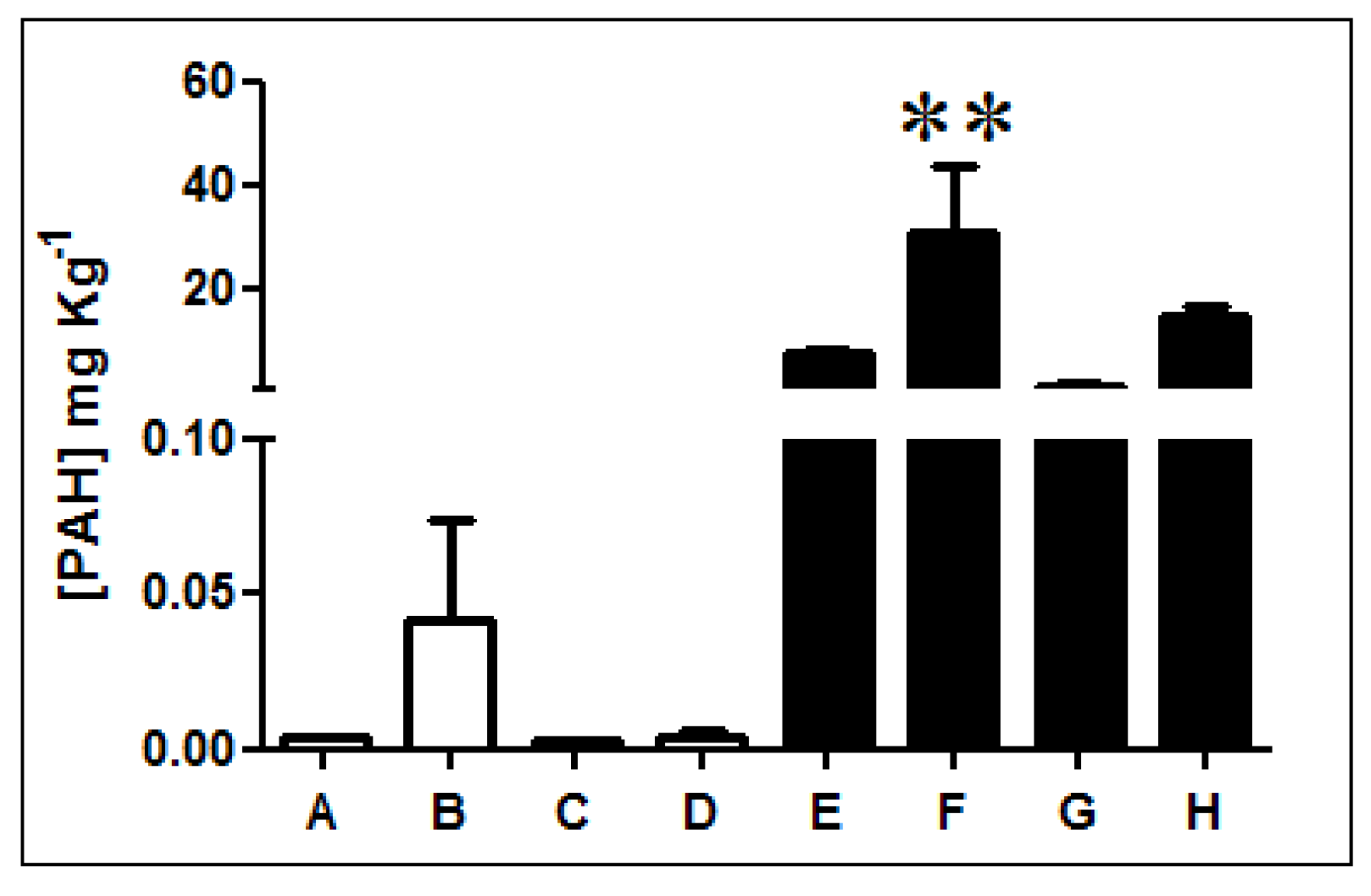

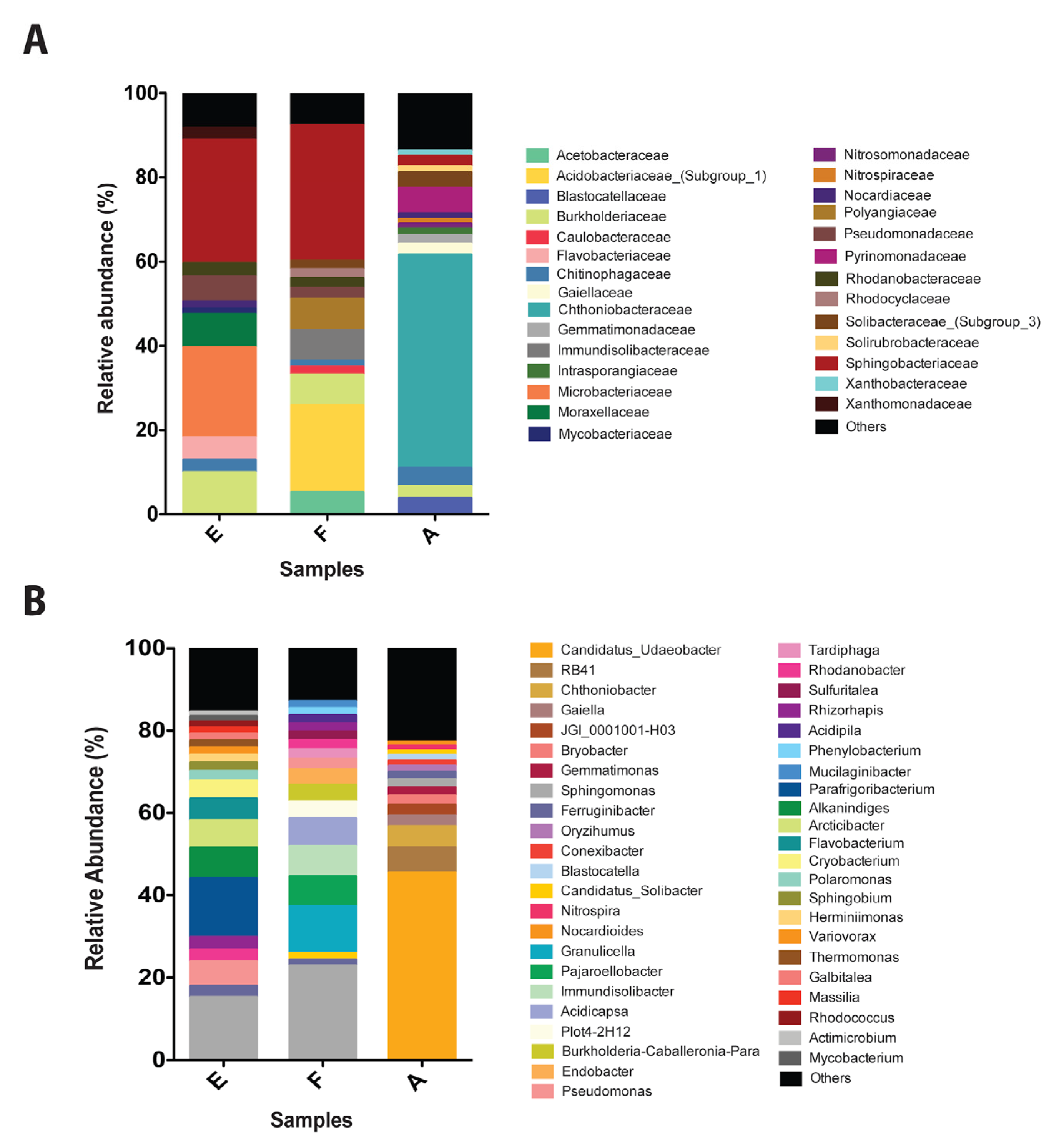
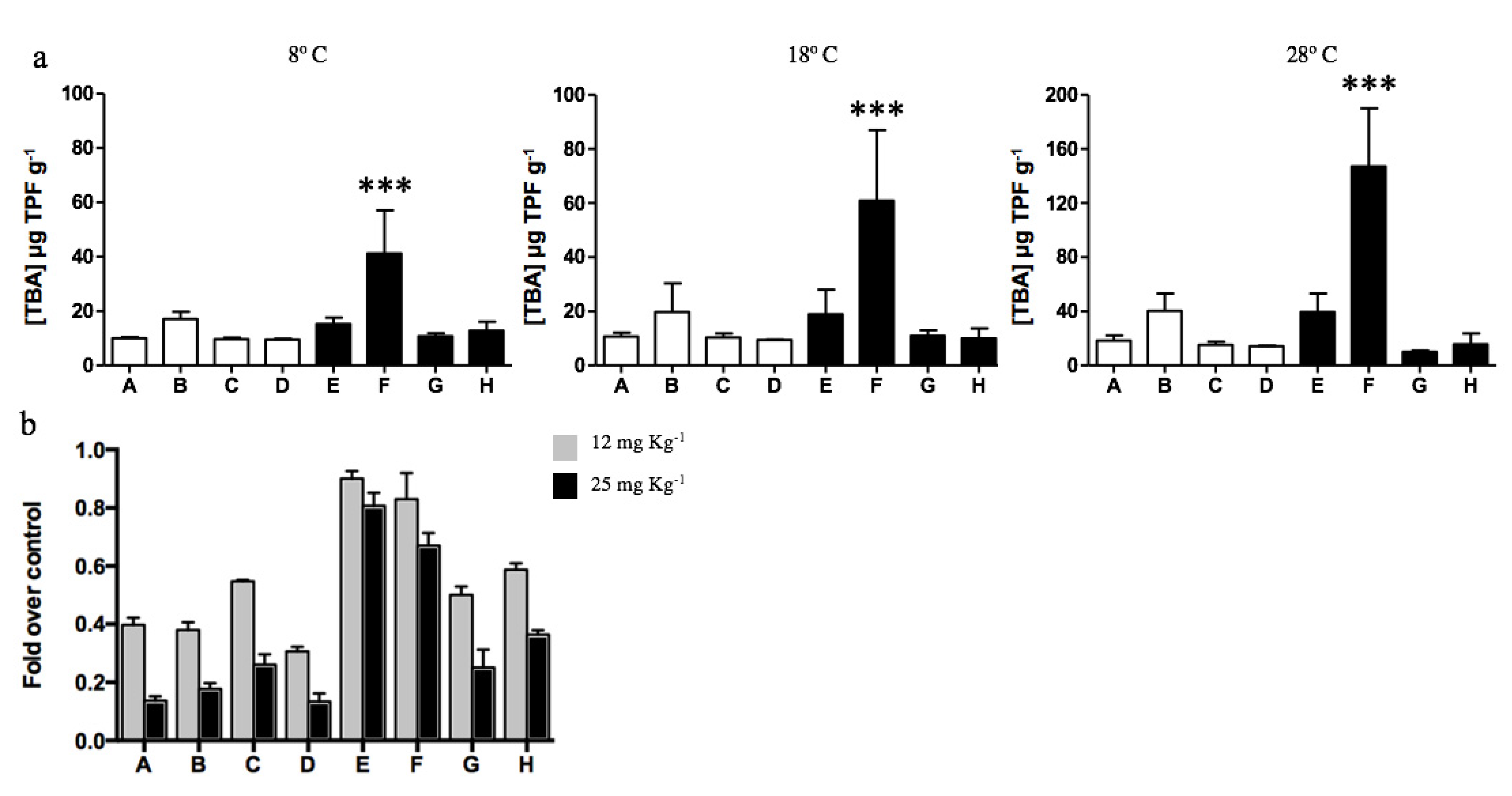
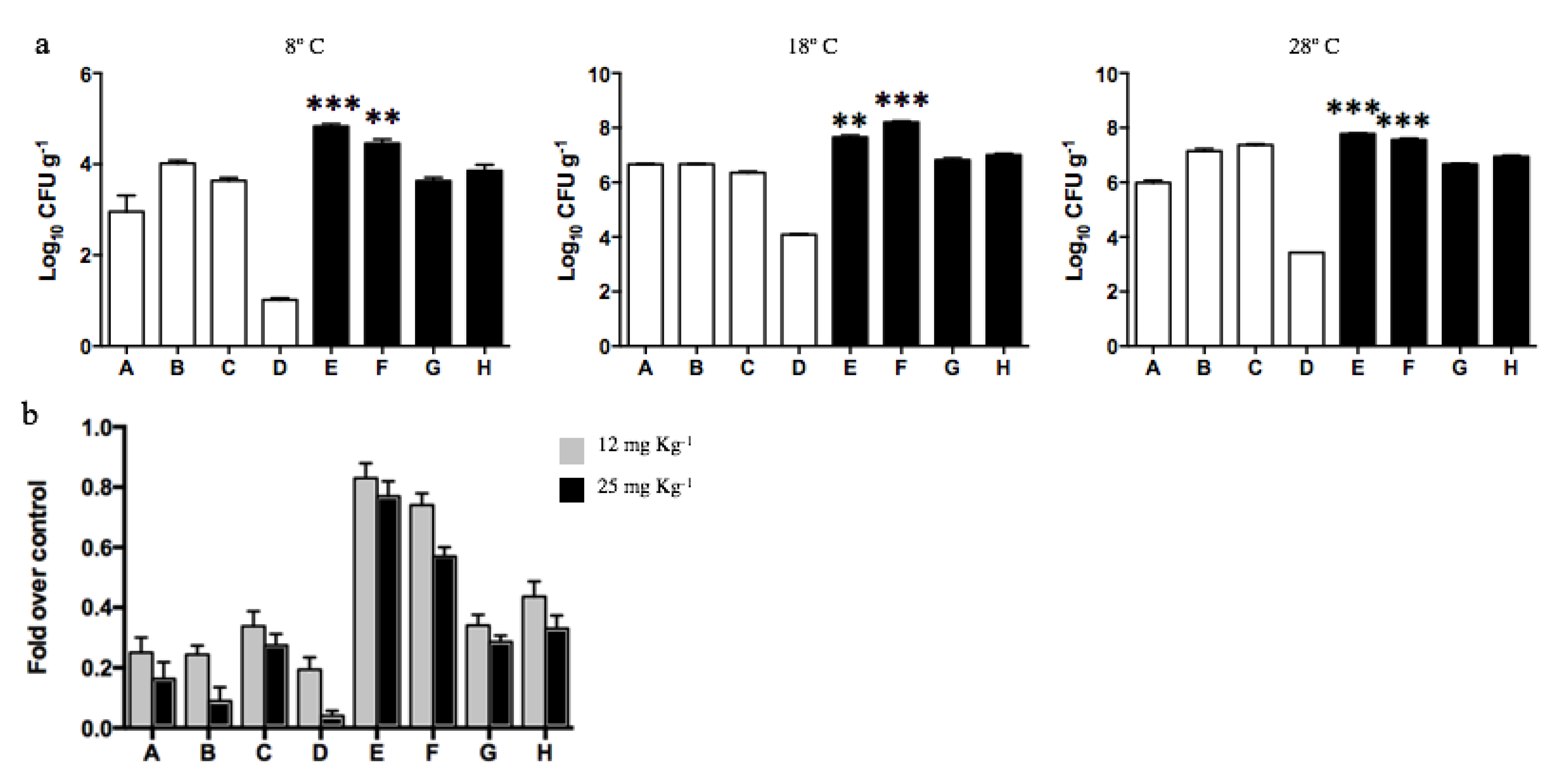

| Sample | Exposure to Diesel | Latitude | Longitude | Temperature |
|---|---|---|---|---|
| A | Non-exposed | 62°25 S | 59°46 W | 1 °C |
| B | Non-exposed | 62°26 S | 59°23 W | 3 °C |
| C | Non-exposed | 62°38 S | 60°36 W | 3 °C |
| D | Non-exposed | 62°58 S | 60°34 W | 3 °C |
| E | Exposed | 62°19 S | 57°53 W | 0 °C |
| F | Exposed | 62°19 S | 57°55 W | 0 °C |
| G | Exposed | 62°11 S | 58°58 W | 5 °C |
| H | Exposed | 62°13 S | 58°57 W | 9 °C |
Publisher’s Note: MDPI stays neutral with regard to jurisdictional claims in published maps and institutional affiliations. |
© 2020 by the authors. Licensee MDPI, Basel, Switzerland. This article is an open access article distributed under the terms and conditions of the Creative Commons Attribution (CC BY) license (http://creativecommons.org/licenses/by/4.0/).
Share and Cite
Gran-Scheuch, A.; Ramos-Zuñiga, J.; Fuentes, E.; Bravo, D.; Pérez-Donoso, J.M. Effect of Co-contamination by PAHs and Heavy Metals on Bacterial Communities of Diesel Contaminated Soils of South Shetland Islands, Antarctica. Microorganisms 2020, 8, 1749. https://doi.org/10.3390/microorganisms8111749
Gran-Scheuch A, Ramos-Zuñiga J, Fuentes E, Bravo D, Pérez-Donoso JM. Effect of Co-contamination by PAHs and Heavy Metals on Bacterial Communities of Diesel Contaminated Soils of South Shetland Islands, Antarctica. Microorganisms. 2020; 8(11):1749. https://doi.org/10.3390/microorganisms8111749
Chicago/Turabian StyleGran-Scheuch, Alejandro, Javiera Ramos-Zuñiga, Edwar Fuentes, Denisse Bravo, and José M. Pérez-Donoso. 2020. "Effect of Co-contamination by PAHs and Heavy Metals on Bacterial Communities of Diesel Contaminated Soils of South Shetland Islands, Antarctica" Microorganisms 8, no. 11: 1749. https://doi.org/10.3390/microorganisms8111749
APA StyleGran-Scheuch, A., Ramos-Zuñiga, J., Fuentes, E., Bravo, D., & Pérez-Donoso, J. M. (2020). Effect of Co-contamination by PAHs and Heavy Metals on Bacterial Communities of Diesel Contaminated Soils of South Shetland Islands, Antarctica. Microorganisms, 8(11), 1749. https://doi.org/10.3390/microorganisms8111749




